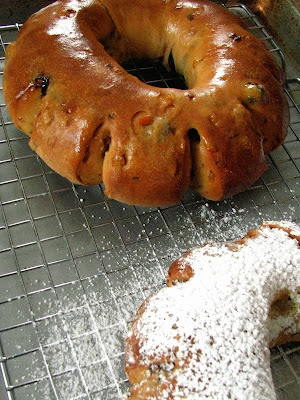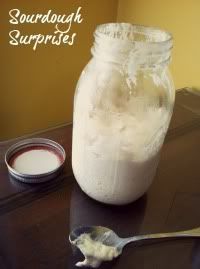
I soaked my raisins for 3 days in dark rum:


Candied Peel (Elizabeth LaBau)
- 3 oranges, or you could substitute 2 grapefruit or 4 lemons (I used 4 oranges and 1 lemon)
- 4 cups sugar, plus more for rolling
- 4 cups water
Remove the segments of peel carefully, trying not to tear them. Cut the peel into thin strips between ¼ inch to ½ inch wide. If using fruit with a very thick skin, you might want to use a paring knife to slice away some of the bitter white pith, but if it’s a thinner-skinned fruit, you can skip this step.
Place the strips in a large saucepan and cover them with cold water. Bring the water to a boil, then drain the pot.
Repeat this process two more times. This step removes a lot of the bitterness from the peels and makes the final product much sweeter, but don’t worry, some of the citrus tang remains.
Once the strips have been boiled 3 times, combine the 4 cups of sugar and 4 cups of water in a saucepan and bring it a boil, stirring occasionally until the sugar dissolves. Wipe the sides of the pan with a wet pastry brush to prevent sugar crystals from forming, then add the orange peels to the boiling syrup. Reduce the heat to medium-low and continue to simmer the peels for an hour. By the end of this time they should be very limp and start to look translucent.
Remove the pan from the heat, and let the strips cool in the syrup.
Take the peels from the syrup and place them on a wire cooling rack set over a baking sheet. Let them drip and dry for about 30 minutes, then roll them in granulated sugar. Place them back on the wire rack in a single layer, and let them dry overnight at room temperature. If you need to speed up this process, you can put them in the oven on the lowest setting for about 30 minutes






- ¼ cup (60ml) lukewarm water (110º F / 43º C)
- 2 packages (4 1/2 teaspoons) (22 ml) (14 grams) (1/2 oz) active dry yeast
- 1 cup (240 ml) milk
- 10 tablespoons (150 ml) (140 grams) unsalted butter (can use salted butter)
- 5½ cups (1320 ml) (27 ozs) (770 grams) all-purpose (plain) flour (Measure flour first - then sift- plus extra for dusting)
- ½ cup (120 ml) (115 gms) sugar
- ¾ teaspoon (3 ¾ ml) (4 ½ grams) salt (if using salted butter there is no need to alter this salt measurement)
- 1 teaspoon (5 ml) (6 grams) cinnamon (I used the spicy cassia)
- 3 large eggs, lightly beaten
- Grated zest of 1 lemon and 1 orange
- 2 teaspoons (10 ml) (very good) vanilla extract
- 1 teaspoon (5 ml) lemon extract or orange extract
- ¾ cup (180 ml) (4 ¾ ozs) (135 grams) mixed peel (link below to make your own)
- 1 cup (240 ml) (6 ozs) (170 gms) firmly packed raisins
- 3 tablespoons (45ml) rum (I used 3 T. rum every day for three days, and the raisins soaked nearly all of it up! I added the raisins and any remaining rum to the dough.)
- 12 red glacé cherries (roughly chopped) for the color and the taste. (optional) (I used dried, organic, tart cherries)
- 1 cup (240 ml) (3 ½ ozs) (100 grams) flaked almonds
- Melted unsalted butter for coating the wreath
- Confectioners’ (icing) (powdered) sugar for dusting wreath
Note: If you don’t want to use alcohol, double the lemon or orange extract or you could use the juice from the zested orange.
Soak the raisins
In a small bowl, soak the raisins in the rum (or in the orange juice from the zested orange) and set aside. See Note under raisins.
To make the dough
Pour ¼ cup (60 ml) warm water into a small bowl, sprinkle with yeast and let stand 5 minutes. Stir to dissolve yeast completely.
In a small saucepan, combine 1 cup (240 ml) milk and 10 tablespoons (150 ml) butter over medium - low heat until butter is melted. Let stand until lukewarm, about 5 minutes.
Lightly beat eggs in a small bowl and add lemon and vanilla extracts.
In a large mixing bowl (4 qt) (4 liters) (or in the bowl of an electric mixer with paddle attachment), stir together the flour, sugar, salt, cinnamon, orange and lemon zests.
Then stir in (or mix on low speed with the paddle attachment) the yeast/water mixture, eggs and the lukewarm milk/butter mixture. This should take about 2 minutes. It should be a soft, but not sticky ball. When the dough comes together, cover the bowl with either plastic or a tea cloth and let rest for 10 minutes.
Add in the mixed peel, soaked fruit and almonds and mix with your hands or on low speed to incorporate. Here is where you can add the cherries if you would like. Be delicate with the cherries or all your dough will turn red!
Sprinkle flour on the counter, transfer the dough to the counter, and begin kneading (or mixing with the dough hook) to distribute the fruit evenly, adding additional flour if needed. The dough should be soft and satiny, tacky but not sticky. Knead for approximately 8 minutes (6 minutes by machine). The full six minutes of kneading is needed to distribute the dried fruit and other ingredients and to make the dough have a reasonable bread-dough consistency. You can tell when the dough is kneaded enough – a few raisins will start to fall off the dough onto the counter because at the beginning of the kneading process the dough is very sticky and the raisins will be held into the dough but when the dough is done it is tacky which isn't enough to bind the outside raisins onto the dough ball.
Lightly oil a large bowl and transfer the dough to the bowl, rolling around to coat it with the oil. Cover the bowl with plastic wrap.
Put it in the fridge overnight. The dough becomes very firm in the fridge (since the butter goes firm) but it does rise slowly… the raw dough can be kept in the refrigerator up to a week and then baked on the day you want.
Shaping the Dough and Baking the Wreath
1: Let the dough rest for 2 hours after taking out of the fridge in order to warm slightly.
2: Line a sheet pan with parchment paper.
3: Preheat oven to moderate 350°F/180°C/gas mark 4 with the oven rack on the middle shelf.
4: Punch dough down, roll into a rectangle about 16 x 24 inches (40 x 61 cms) and ¼ inch (6 mm) thick. Starting with a long side, roll up tightly, forming a long, thin cylinder.
Using kitchen scissors, make cuts along outside of circle, in 2-inch (5 cm) intervals, cutting 2/3 of the way through the dough.
Twist each segment outward, forming a wreath shape. Mist the dough with spray oil and cover loosely with plastic wrap.
Proof for approximately 2 hours at room temperature, or until about 1½ times its original size.
Bake the stollen for 20 minutes, then rotate the pan 180 degrees for even baking and continue to bake for 20 to 30 minutes. The bread will bake to a dark mahogany color, should register 190°F/88°C in the center of the loaf, and should sound hollow when thumped on the bottom.
Transfer to a cooling rack and brush the top with melted butter while still hot.
Immediately tap a layer of powdered sugar over the top through a sieve or sifter.
Wait for 1 minute, then tap another layer over the first.
The bread should be coated generously with the powdered sugar.
Let cool at least an hour before serving. Coat the stollen in butter and icing sugar three times, since this many coatings helps keeps the stollen fresh - especially if you intend on sending it in the mail as Christmas presents!
When completely cool, store in a plastic bag. Or leave it out uncovered overnight to dry out slightly, German style.
Storage:
The more rum and the more coatings of butter and sugar you use the longer it will store. The following is for the recipe as written and uses the 45 mls of rum and two coatings of butter and icing sugar.Stollen freezes beautifully about 4 months. The baked stollen stores well for 2 weeks covered in foil and plastic wrap on the counter at room temperature and one month in the refrigerator well covered with foil and plastic wrap.















wow, these are beautiful! And the candied peel looks divine on its own, too.
ReplyDelete